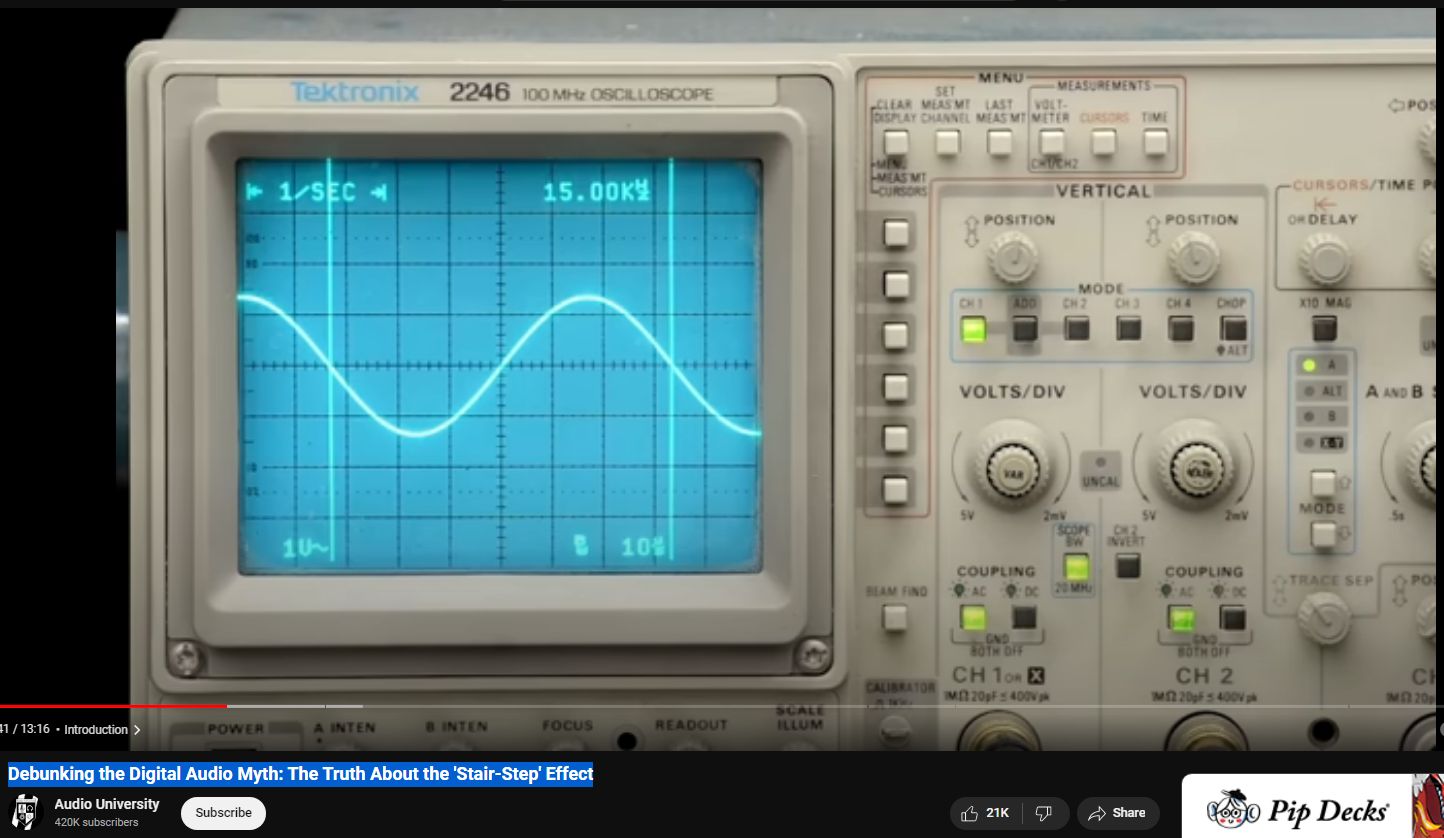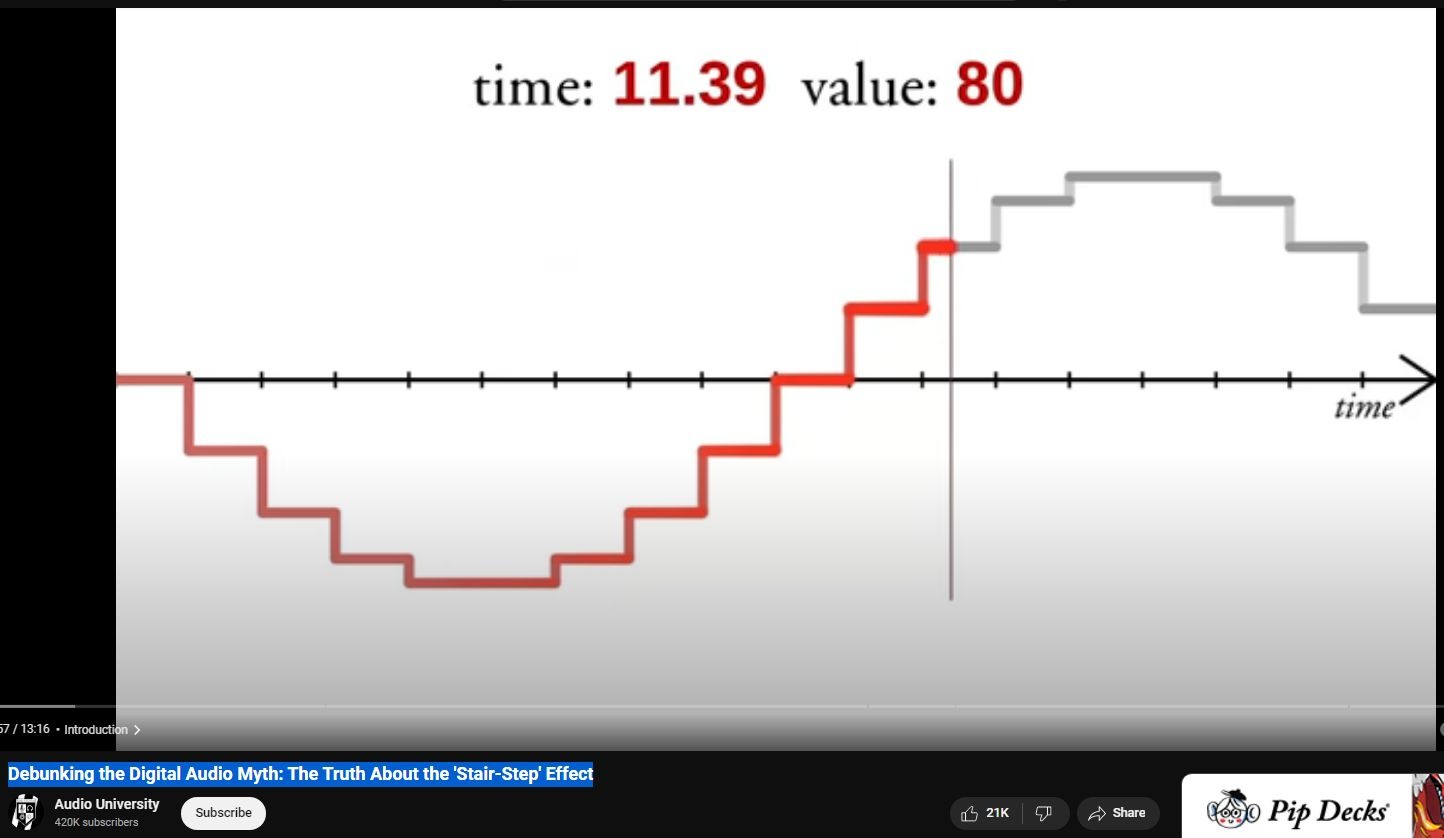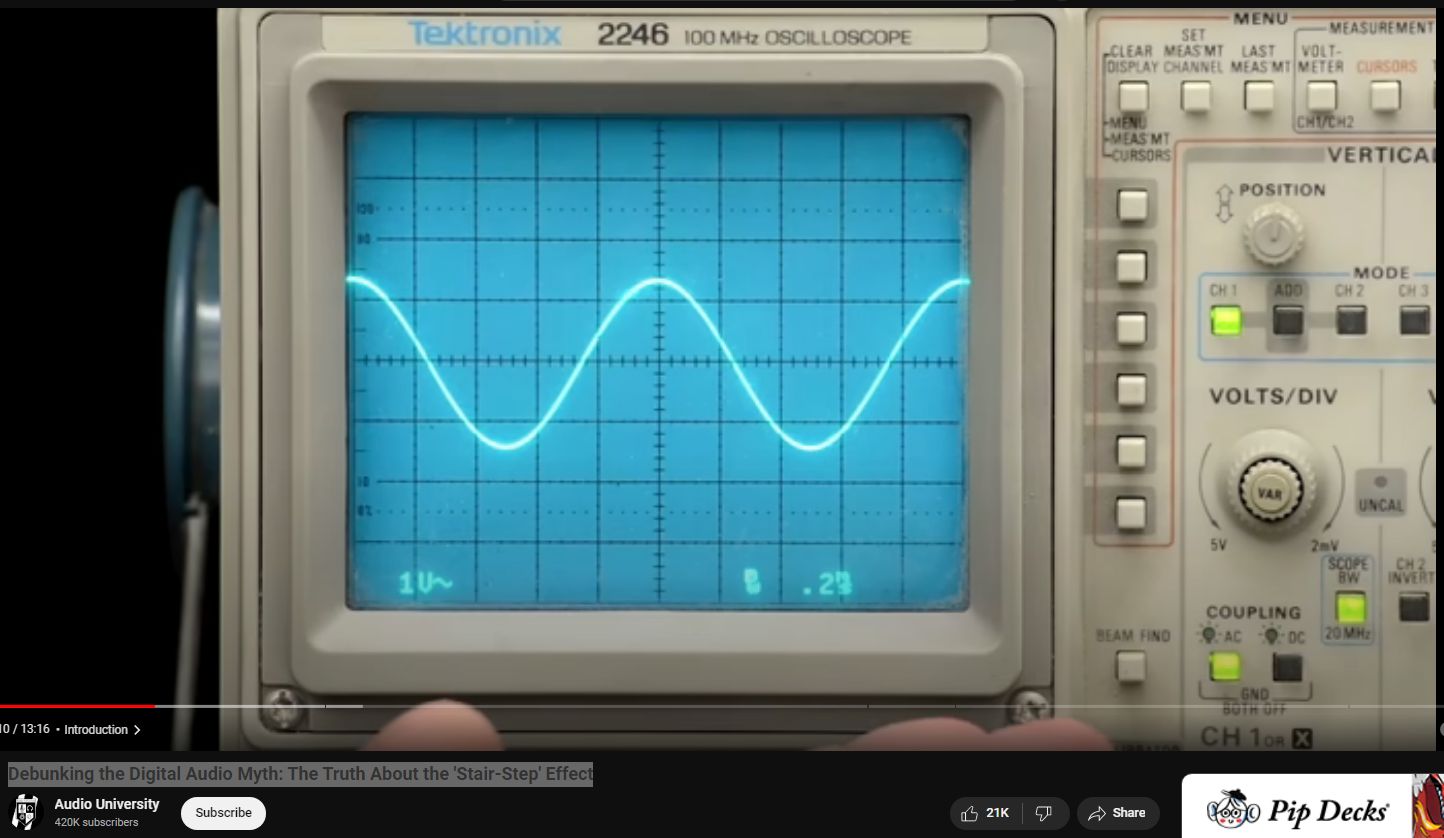Does phase and transient response in fact matter to fidelity?
“Isn’t insisting ‘no audible difference between analog and digital’ exactly the same thing as claiming there is no audible difference between a fretless bass and a fretted bass, when hearing both through pillow over ears, earplugs in, or head in sand?”
A higher sample-rate should result in a more accurate capture and reproduction of the signal.
Analog wave digitized, then converted back to analog: Exactly like original sinewave.
A 15 kHz sinewave is being represented digitally by fewer than 3 samples per cycle. Digital waveform looks awful, but smoothed analog output looks perfect, imperceptible from analog input; a perfect sinewave. Imperceptible. “Exactly like the original.”
No jagged edges; no drop-offs; no stair-steps.

From the comments:
“Higher bit “depth” was actually Required for doing digital mixing and/or fade-in / fade-out, which turned into objectionable quantized noise and was The early and extremely obvious serious shortcoming of “digital audio”. That the “bigger is better” / “more is better” marketing yipyap took over is painfully obvious to those with minds to understand.”
“If 20 kHz is the upper “limit” as mentioned, then why can anyone instantly hear stark differences between 15 kHz sinewave and 15 kHz squarewave ? The first “difference” is theoretically the third harmonic of the squarewave at 45 kHz, more than double beyond our “limit”. Clearly something else is contributing to the blatantly audible difference.”
“It is a pity that the embedded video did not explain why the step function is not the end-result of digital analog conversion: namely that the signal is subject to subsequent thorough low-pass filtering. Without this information the nice harmonic output of a DAC is surely quite mysterious.”
“Some of the reasons to sample higher than 44.1 kHz was to make anti aliasing filter less steep to avoiding aliasing. This filter is in the frontend and analogue, so the filter is cheaper and gives less phase distortion. If the signal is oversampled many times you can take advantages to noise shape the spectrum (place the noise in the frequency range you will filter away).”
“If you want to hear a good example of quantization noise, the Game Boy Advance has digital sound channels that are limited to 8 bits. Accordingly, many games sound like they have tape-like hiss, but only when sound is actually playing.”
“One effect not explored in these experiments is the phase of the signal. As the pitch of the signal approaches the Nyquist limit, while you still have the frequency itself preserved as a pure tone, its phase will be more and more forcibly synchronized to the samples. This interferes with binaural listening for which we use stereophonic sound reproduction. This would be why it would be that played from a CD, while a violin or a trumpet would be easily localizable to the human pair of ears, a cymbal, full of extremely high frequencies and transients, will tend to sound as if it is coming from all over the place, and not at all as if it comes from where it had in fact been located. True pure analog recording does not have this problem.”
“Key to this is limiting the bandwidth of the sampled signal. With proper low pass filtering, frequencies above Nyquist are eliminated and there will be no aliasing noise. However, oversampling can simplify the input filter complexity and the high frequency content (noise) can then be filtered digitally and downsampled to generate the output digital stream at 44.1K or 48K samples per second.”
“The problem with this simplistic experiment using a single frequency, continuous sine wave is that it completely eliminates any discussion of phase shift. Go to a high end audio store and listen to some music recorded on a CD that is played back on a player with 4 and 8x oversampling. The difference will astound you. Why? Oversampling permits the use of a lower order filter to reconstruct the analog waveform from rhe samples. What you don’t hear discussed in the video is that filters (that reconstuct the signal) have varying phase shifts at different frequencies. Phase shift is time delay and that in turn makes the tones you hear move spatially in the audio you hear. The closer to Nyquist the sampling rate the sharper the filter rolloff needed for reconstruction which in turn necessitates a higher order filter with, you guessed it, a much more distorted phase response. So while 44 kHz audio meets the Nyquist criterion to recover the frequency content, it won’t be sufficient to get all the phase info you need for crisp sounding stereo audio. Oversampling is critical for good audio.”
“I would guess they use 24 bit high sample rate in music production for essentially the same reason movie producers and Photoshop artists use significantly higher resolution source material than the final product, because when the final rendering is done, any subtle errors in production will be ultimately diminished to the point they are barely if at all noticeable.”
“Good discussion! I stand by my assertion that the best improvement in my stereo was the cheap CD player I bought back in the early 80s. Gone were the days of clicks and pops of vinal! It is interesting that vinal is making a comeback. I think it’s the ritual of the turntable and cleaning that’s the reason. I did double blind testing on very high-end equipment from the late 70s and early 80s and the CD always sounded better. The only thing close was a $5000 turntable/cartridge combo that was awesome! Sounded almost as good as a $130 CD player with a DDD disk.”

—
“The sample rate vs frequency experiment for a steady state tone was a quite convincing experiment. Sorry to say that in the real world of transient sounds, like music, it does not hold up the same.
“Coming from a Digital TV background I recall a demonstration at an Ampex class to demonstrate a problem called aliasing that happens when you have less than full quadrature sampling, in analog TV for Color information at 3.578545 Mhz.
“The normal sample rate used for Time Base Correctors and Frame Synchronizers is 14.31818 Mhz or 4 times the color frequency! This is to properly reproduce all phases of the original color signal at proper amplitude. In the demonstration the sample rate was reduced to 3x color, or 10.738635Mhz. At that sample rate there was very clear degradation in the color signal. There was aliasing causing amplitude and phase errors to appear, but for a consumer reference, it was still better than the average VHS home recording!
“When the sample rate was reduced to 2x color, or 7.15909 Mhz, only colors that phase agreed with the phase of the samples were correct with the amplitude of anything else was reduced according to the phase difference up to 90 degrees where there was no response. There were, however responses where colors changed as for a few cycles the frequency of the transition moves above or below the exact color frequency. These transitions, however, did not achieve the same amplitude traces as the original signal!
“With this in mind, how does the steady state tone demonstration come up looking so good in this demonstration? Why is it not full of aliasing products? Simply put, it is the D-to-A post filtering that tends to ring to fill in nicely for steady state signals! By the way, the stair-step representation is exactly what comes out of the digital to analog section ahead of the out put filtering. The sampled values are loaded and latched as steady state values at this pre-filter point in the process.The output analog filter smooths this out.
“When Digital audio was new the initial response from Recording Engineers and Musicians alike was WOW, THAT’S GREAT! It was then a leap in quality compared to Ampex 456 or the 3M equivalent analog tapes. They were really good, but always added a sort of what I call a “metalic sound” when comparing live to repro during a live recording. Digital was a lot better as the samples were very accurate in the majority of the audio range and as pointed out extremely quiet, lots of dynamic range. After a while, though, many Engineers and Musicians started noticing a sort of strange new component that most said sounded harsh! Believe it or not, that is the aliasing caused by less than full quadrature sampling!
“As an example, one of many, I was recently approached by a Flute player who was frustrated by the sound of her recordings! They were done with a Neuman large diaphram U-87 type mic that has been a standard for decades. The recording was clean and clear except for some high frequency “trash”. As I have seen many times in the past, a spectrum analysis clearly revealed that the digital signal was “growing” aliasing products from 11.025Khz (quadrature for 44.1 sample rate) and above as louder, higher pitched notes were played! I told her to have her engineer apply a simple lo-pass filter to the recording starting around 12 Khz and like magic the aliasing products were no longer a problem.
“As for analog never having the dynamic range of digital, I am sad to say that both Ampex (Quantigy) and 3M came out with what they called “HIGH LEVEL TAPE” to try to recover from the digital revolution! They recommended setting your 0db record reference at 9 db above the standard 0db reference! I did this on my old Scully 280 and proceeded to do a run with a Sound Technology distortion analyzer. When the analyzer reached 27db above the elevated zero the distortion abruptly rose from fractions to 2.4%! I think that was the electronics flat topping, not the tape saturating! The headroom was great and when switching from direct to repro it was near impossible to hear any difference!
“Twenty years or so ago I recorded a live concert with my 1″ 16 track using DBX and the Ampex 499 high level tape and the result was stunning! The recording was extremely quiet and dynamic sounding, but having said that, an XR-18 to a laptop with Pro Tools is a lot easier and sounds just as good!”
Highly respected audio engineer of Reference Recordings debunks everything in this entire video here:
https://youtu.be/bBR3kS4e_wk?si=ACKrURL5YTnfW1xt
Videos like the one on this channel are simplistic misinformation for people who don’t have any understanding. RMAF10: High Resolution from the Masters — https://www.youtube.com/@RMAudiofest — Rocky Mountain International Audio Fest
